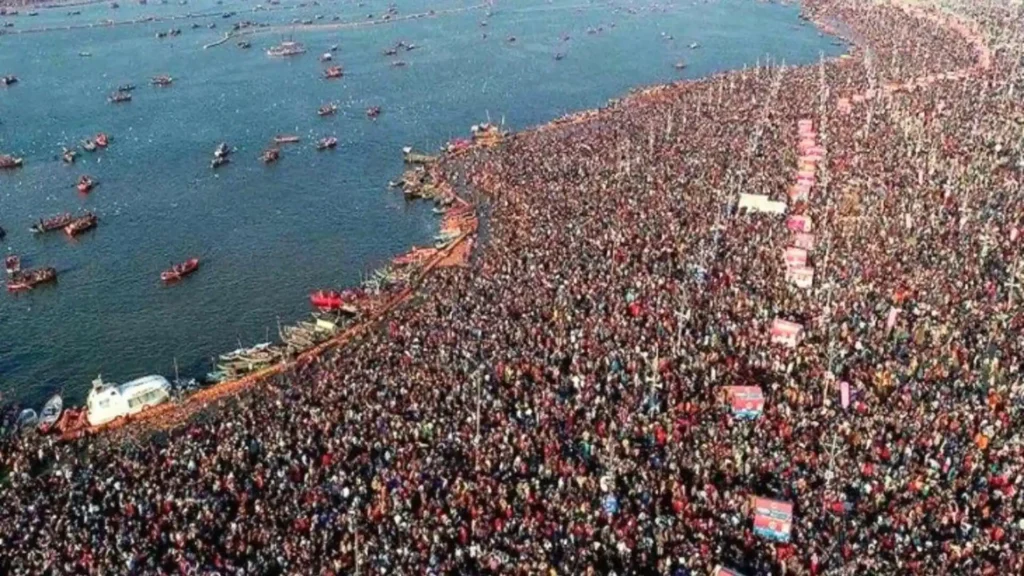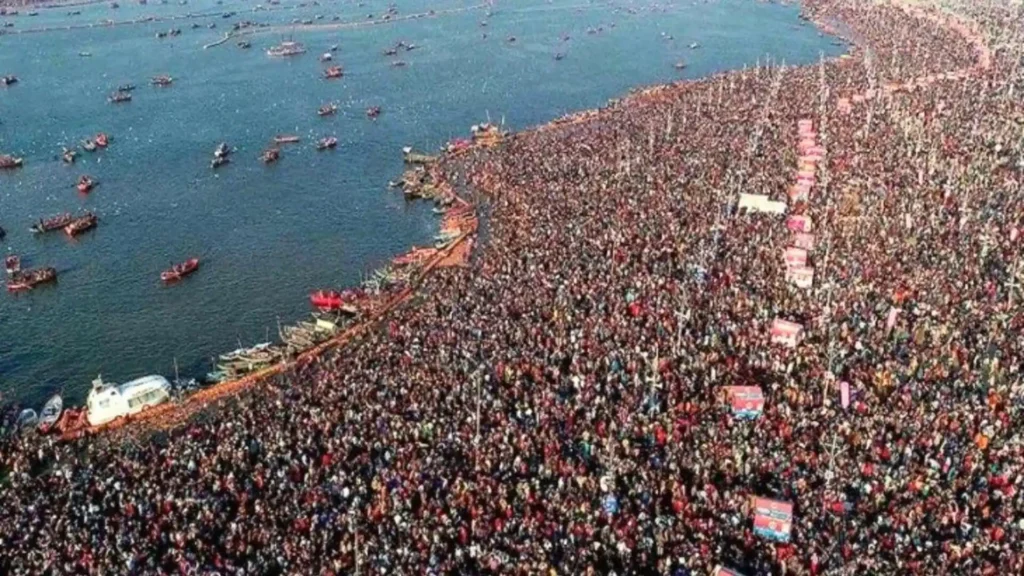
Mahakumbh 2025: A Journey Through Hindu Mythology
The Kumbh Mela is one of the largest and most sacred religious gatherings in the world, where millions of Hindu devotees gather to bathe in holy rivers to cleanse their sins. Here’s a detailed history with factual information:
1. Mythological Origins(History)
- The Kumbh Mela traces its origins to the Samudra Manthan (churning of the ocean) mentioned in Hindu Puranas (Vishnu Purana, Bhagavata Purana, Mahabharata).
- According to legend, gods (Devas) and demons (Asuras) churned the ocean for Amrita (nectar of immortality). A 12-day battle ensued over the Kumbh (pot) containing the nectar.
- During the struggle, drops of Amrita fell at four places:
- Prayagraj (Allahabad, at the confluence of Ganga, Yamuna, and Saraswati)
- Haridwar (River Ganga)
- Nashik (Godavari River)
- Ujjain (Shipra River)
- Since 1 divine day = 1 human year, the Kumbh Mela is celebrated every 12 years at each location.
- 2. Historical Evidence
- The earliest written mention of the Kumbh Mela comes from Chinese traveler Xuanzang (Hiuen Tsang) in 629–645 CE, during Harsha’s reign. He described a grand festival at Prayag where half a million people gathered.
- Adi Shankaracharya (8th century CE) is believed to have formalized the Kumbh Mela to promote Hindu unity.
- The Khalsa Sikh leader Guru Nanak (15th century) visited the Kumbh Mela, as recorded in Sikh scriptures.
- The Mughal Emperor Akbar (16th century) attended the Kumbh Mela and donated generously.
- 3. Evolution of the Kumbh Mela
- Haridwar Kumbh Mela: Fixed by astrological positions of Jupiter in Aquarius (Kumbh Rashi) and the Sun in Aries.
- Prayagraj Kumbh Mela: Occurs when Jupiter is in Taurus and the Sun and Moon are in Capricorn.
- Nashik & Ujjain Kumbh Mela: Held when Jupiter is in Leo (Simha Rashi).
- Ardh Kumbh Mela (Half Kumbh) is held every 6 years at Haridwar and Prayagraj.
- Maha Kumbh Mela occurs every 144 years (after 12 cycles) only in Prayagraj.
- 4. British and Modern Records
- The 1796 Kumbh Mela in Haridwar was disrupted by a stampede, leading to British documentation.
- The 1857 Prayagraj Kumbh Mela saw reduced attendance due to the Indian Rebellion.
- 1954 Kumbh Mela (Prayagraj): A stampede killed 800 people, leading to better crowd management.
- 2001 Kumbh Mela (Prayagraj): Over 60 million people attended, making it the largest human gathering in history (recorded by UNESCO).
- 2013 Kumbh Mela (Prayagraj): Recognized by UNESCO as an Intangible Cultural Heritage of Humanity.
- 2019 Kumbh Mela (Prayagraj): Attracted 120 million pilgrims, with advanced crowd control using AI and drones.
- 5. Significance & Rituals
- Shahi Snan (Royal Bath): The most sacred event, led by Naga Sadhus (ascetic warriors) and Akharas (monastic orders).
- Kalpavasis: Devotees stay for a month, living an austere life.
- Cultural & Spiritual Discourses: Saints and scholars hold discussions on Hindu philosophy.
- 6. Scientific & Cultural Impact
- The Kumbh Mela is studied for mass gathering medicine, logistics, and urban planning.
- Temporary cities are built with hospitals, roads, and sanitation systems.

Get ready for Mahakumbh 2025!
the Kumbh Mela 2025 in Prayagraj (Allahabad) is still in the planning and early execution phase, with official data on crowd size, management strategies, and costs yet to be fully released. However, based on recent reports from The Hindu, Indian Express, The Print, and Mint, here’s the latest available information:
Dates & Important Bathing Days
Maha Shivratri (26 Feb) – Largest gathering
Duration: January 14 (Makar Sankranti) to March 2025
Major Snan (Bathing) Dates:
Makar Sankranti (14 Jan) – First holy dip
Mauni Amavasya (30 Jan) – Most auspicious day
Basant Panchami (2 Feb)
1. Expected Crowd & Duration
A. Security & Crowd Control
- Dates: January 14 (Makar Sankranti) to March 2025 (key bathing dates: Makar Sankranti, Mauni Amavasya, Basant Panchami, Maha Shivratri).
- Expected Footfall:
- 120–150 million pilgrims (based on 2019 figures).
- 50–60 million on peak bathing days (Maha Shivratri, Mauni Amavasya).
- The Hindu (Dec 2024) reported that UP govt is preparing for over 30 crore visitors across 2 months.
2. Management & Infrastructure
- AI & Tech-Based Monitoring:
- Indian Express (Jan 2025): Drones, CCTV with facial recognition, and RFID tracking for lost persons.
- AI-powered crowd analytics to prevent stampedes (used in 2019, now upgraded).
- Police & Forces:
- 40,000+ police personnel (CRPF, UP Police, NDRF).
- Mint (Feb 2025): Special women’s safety squads and lost-and-found hubs.
B. Health & Sanitation
- Hospitals & Medical Camps:
- 20+ temporary hospitals, 500+ health camps (The Print, Jan 2025).
- WHO-approved disease surveillance for COVID-19, cholera, and heatstroke.
- Sanitation:
- 1.2 lakh toilets, bio-toilets near riverbanks (UP govt data).
C. Transportation & Logistics
- Roads & Traffic:
- 500 km of temporary roads, 22 pontoon bridges (Indian Express).
- Parking for 1.5 lakh vehicles.
- Rail & Air:
- 1,000+ extra trains (Indian Railways).
- Prayagraj Airport expansion to handle 500+ flights.
3. Estimated Cost & Budget
- Total Budget: ₹4,000–5,000 crore (UP govt + Centre).
- The Hindu (Nov 2024): ₹2,500 crore allocated by UP govt, rest from central funds.
- Mint (Dec 2024): ₹1,200 crore for sanitation, ₹800 crore for security tech.
- Private Sponsorships:
- Adani Group, Tata, Reliance funding infrastructure (The Print).
4. Environmental & Economic Impact
- River Cleaning: ₹300 crore spent on Ganga-Yamuna cleanup (NGT orders).
- Economic Boost:
- ₹1.2 lakh crore expected business (hotels, shops, tourism).
- Indian Express reported 5 lakh+ temporary jobs created.
The Kumbh Mela 2025 is more than a pilgrimage—it’s a celebration of faith, unity, and India’s ancient traditions. With cutting-edge management, massive economic benefits, and global attention, this event will once again showcase the power of collective devotion.

Great